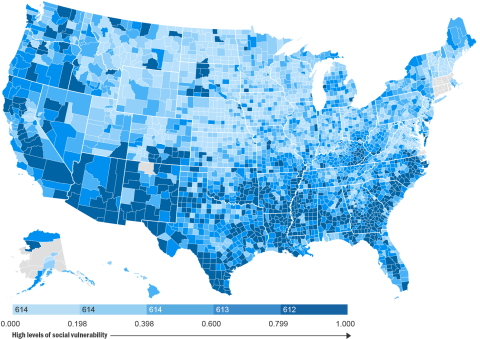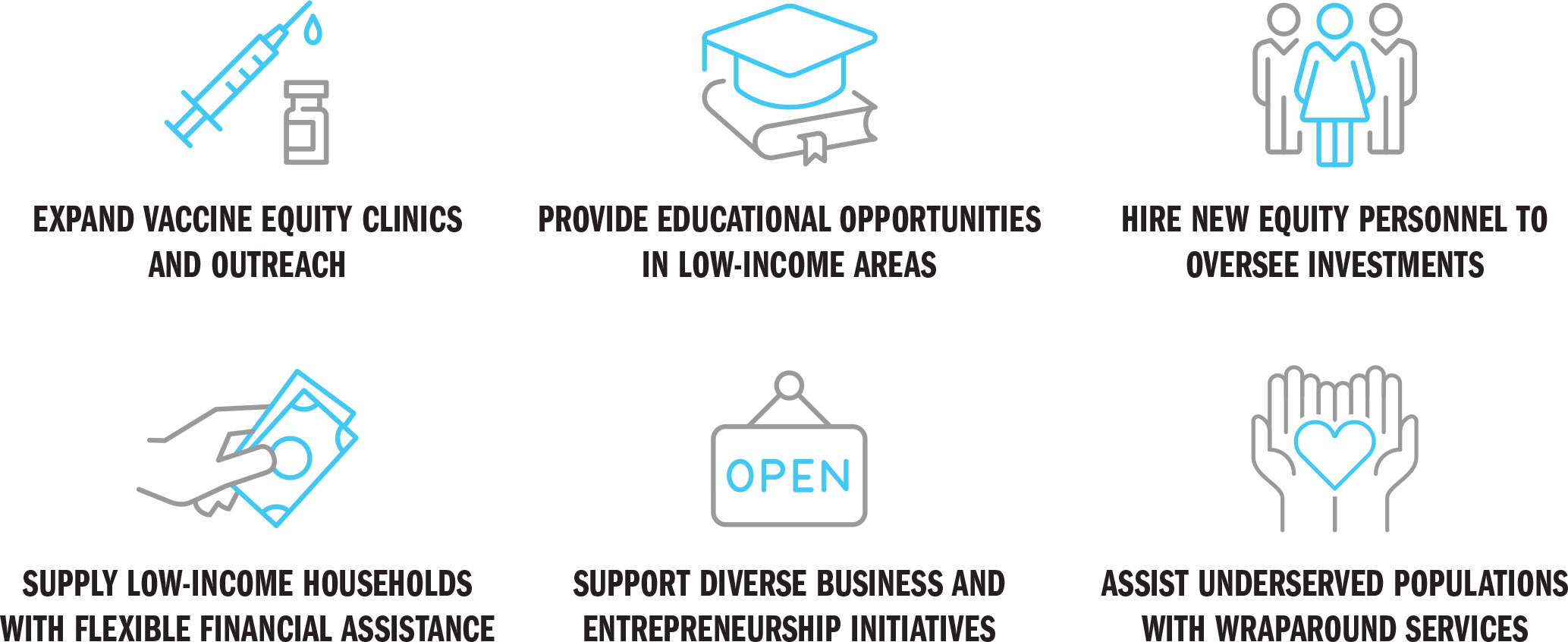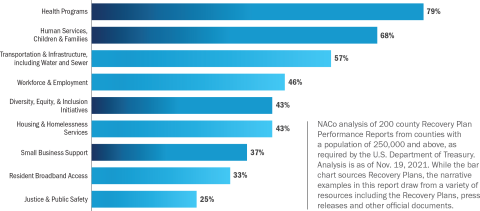Counties and the American Rescue Plan Act Recovery Fund: Equity
Upcoming Events
Related News
SOCIAL VULNERABILITY INDEX ACROSS THE NATION
The social vulnerability index measures a number of factors such as poverty, lack of transportation and poor housing conditions that may weaken a community’s capacity to respond to a disaster or external stress. Across the nation, there are varied levels of social vulnerability that exacerbate inequities and can make residents more susceptible to COVID-19’s negative economic and social impacts.

Map: 2018, U.S. Department of Health and Human Services - Agency for Toxic Substances and Disease Registry
COUNTIES PLAN TO INVEST RECOVERY FUNDS TO:

COUNTIES ARE INTEGRATING DIVERSITY, EQUITY & INCLUSION INTO KEY GOVERNMENT SERVICES
How will counties invest the funds? NACo analysis of 200 county ARPA Recovery Fund plans reveals county-designed investments in the community across key areas of need. These local priorities are found within county plans at the rate displayed in the chart, e.g. forty-three percent of county plans include investments in diversity, equity & inclusion initiatives. The darker bars are the investment categories adjacent to equity that support the continuation and expansion of services in counties. The examples in this report further illustrate the allocations to support equitable programs and services on the local level.

THE RECOVERY FUND AND EQUITYThe Coronavirus State and Local Fiscal Recovery Fund (Recovery Fund), part of the American Rescue Plan Act (ARPA), which NACo helped to develop and strongly advocated to pass, allocates $65.1 billion. These funds provide direct, flexible aid for every county, parish and borough in America. Counties are on the front lines in delivering this aid to residents and are a driving force connecting communities and strengthening the economy. As directed by the ARPA and the U.S. Department of Treasury, counties can invest Recovery Funds into a broad range of programs, services and projects under five categories to: support the public health response; address negative economic impacts caused by COVID-19; replace lost revenue; provide premium pay to essential workers; and invest in water, sewer and broadband infrastructure. Since the enactment of the ARPA, America’s counties have been working hard to develop Recovery Fund implementation plans that will help spur an equitable economic recovery across the nation. As sound financial stewards, counties are investing these critical Recovery Funds to ensure the health and well-being of our nation’s residents and the economic vitality of our local communities. Many counties are in the preliminary stages of development and implementation of Recovery Fund Plans. This report highlights county investments such as assistance for diverse business owners, health equity initiatives and flexible assistance to low-income households. |
ADAMS COUNTY, COLO.Adams County has set aside $1 million for vaccine equity clinics and incentives, in addition to $92,000 for a new Social Justice/ Race Equity Coordinator to help fulfill ARPA’s directive and assist in the development of programs that eliminate racial and ethnic disparities. The coordinator will also lead the development of the county’s Racial Equity Action Plan. | |
COLLIER COUNTY, FLA.Collier County will provide 200 Wi-Fi hotspots in low-income neighborhoods and expand educational sessions at county libraries with a $4 million investment in high poverty districts that struggled to maintain operations during the pandemic. Another $901,000 will be allocated to add library materials in diverse languages, and $2.2 million is set aside to address the social determinants of health through nutrition classes, financial education and mentorship for underserved communities. | |
CONTRA COSTA, CALIF.Contra Costa County is addressing disparities in public | |
HARRIS COUNTY, TEXASHarris County developed a robust equity framework to ensure ARPA investments are allocated in an equitable fashion. The framework focuses on disaggregating historical data and outcome measures by race, ethnicity and gender to reduce disparities in health, social and economic outcomes. The county’s allocations to date include $32 million for flexible financial assistance to low-income households that have experienced economic hardship due to the pandemic. | |
LEON COUNTY, FLA.Leon County has extended the SmartSteps Program, a micro-loan initiative for Black, minority-owned and women-owned businesses. The program was allocated $1.1 million in Recovery Funds and aims to enhance and diversify the existing capital pool in the county, as well as address the uneven economic impacts of the pandemic. | |
LOS ANGELES COUNTY, CALIF.Los Angeles County’s Phase One ARPA plan allocates $567 million for equity-based investments, including $400 million for housing and homelessness services and $47 million for the Care First, Jails Last program. The Care First, Jails Last initiative supports community-based diversion and reentry as an alternative to jails, and provides wraparound supports for residents who have struggled to secure employment in the wake of the pandemic. | |
MONTGOMERY COUNTY, MD.Montgomery County is supporting a variety of equity programs including expanding the Working Families Income Supplement to financially assist households with children; allocating | |
MULTNOMAH COUNTY, ORE.Multnomah County incorporated equity into every aspect of the official ARPA planning process to ensure funds were being invested sustainably. Overall, the county allocated $816,000 | |
OAKLAND COUNTY, MICH.Oakland County is utilizing Recovery Funds to provide flexible financial assistance for individuals who face barriers to education or other credential programs. Additionally, the county set aside $1.2 million for enhanced services for child welfare-involved families who are facing continued negative economic impacts and strain from the pandemic. | |
PIERCE COUNTY, WASH.Pierce County is supporting Black, Indigenous, and People of Color (BIPOC) entrepreneurship and technical assistance programs through a $5 million investment of Recovery Funds. Another | |
RAMSEY COUNTY, MINN.Ramsey County is assisting young adults who have been negatively impacted by COVID-19 through the “Right Track Plus” initiative which provides workforce development programs and opportunities. The program was allocated $2.1 million and will provide internships and professional development specifically tailored to a population disproportionately impacted by the economic downturn. | |
THURSTON COUNTY, WASH.Thurston County is targeting minority business owners through |